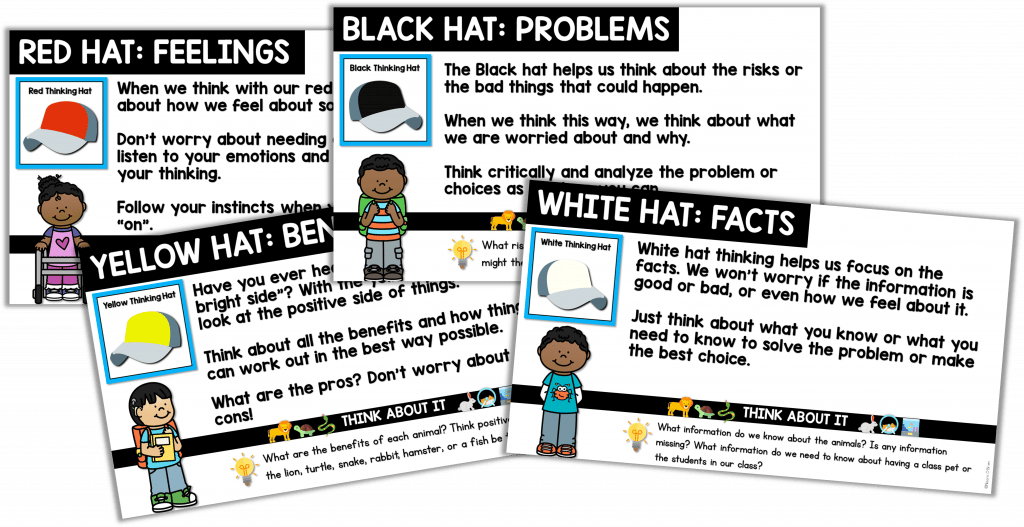

Teacher trends have come and gone over my decade in the classroom, but one practice that’s remained tried and true is teaching higher order thinking skills to all students.
In order to teach students higher order thinking skills, we have to intentionally plan to.
We have to ask higher level questions, plan higher levels lessons, use higher level assessments, and expect high level thinking from our students.
During my 8th year as an educator, I was asked to take on the role of the GT teacher at my site. During my time in that position (after receiving my certification), I was able to attend many trainings and PDs to bring back to the teachers at my school to implement with our students.
In addition to learning how to utilize the depth and complexity icons, staying in the higher level of Bloom’s and using Edward de Bono’s Six Thinking Hats® are two more of the tools I brought into my classroom to use with my students.

What I love about empowering kids to think critically with these hats is that it’s a skill that is needed for the real world. I also love that high level thinking is good for EVERYONE in the room.
Many of the educators I have consulted with and planned with have been taught that the best way to plan lessons is to plan for the grade level you teach and then differentiate a little below and a little above for those that need it.
This sounds good in theory, but what actually happens in the classroom? More often than not, we see students working at grade level and below grade level having their needs met, but students who are working above level or gifted not being challenged or being allowed to think in ways that come naturally to them. If your classroom is only set up to see which students can run, you’ll neve realize who can fly… and they may not either.
But don’t think you have to plan three completely different lessons in order to accommodate everyone. Ain’t nobody got time for that. Planning for the high, divergent thinking, and cluster grouping students can help tremendously! (Read that blog post here)
Lessons I planned using De Bono’s thinking hats have got to be some the coolest memories in the classroom I can think of. Watching young students think critically and examine an issue from multiple perspectives never gets old.

This thinking strategy can be thought of as a tool that helps students explore an issue or brain-storm solving a problem by thinking through up to six different perspectives.

Have you ever met anyone that always has something negative to say when there’s a problem to solve or a decision to make? Sounds like they are doing some black hat thinking.
Or what about someone that just goes with their gut feeling, but doesn’t think about the facts? Or someone who only considers the pros and forgets that weighing the cons can help them make a more informed choice?
Some people default to one main way of thinking. Imagine if instead of only having students use their default way of approaching a problem or making a decision, we set up thinking sessions built into lessons and let them take turns “putting on” each hat and thinking in a new way about academic content.

Using the hats as a thinking strategy during your lessons are a great way to get students engage up and hold everyone accountable for thinking outside-of-the-box. This tool is AWESOME for GT students AND still an incredible tool that all students can use and benefit from. They may need support, but they definitely deserve to be exposed.
The great thing about this tool is that you can use it in any way that meets your needs. All 6 hats and ways of thinking do not all have to be used each time you want to explore multiple perspectives. If you just want to think about facts, pros, cons, and new ideas, you can just use white, yellow, black, and green hat thinking.
You can assign partners or groups a hat color and ask them to think in that way to start a lesson. Students can rotate thinking hats and be required to switch up their thinking to focus on something new within the same lesson.

You can explore one way of thinking whole group and capture student thinking down on chart paper or have students draw/write on thinking mats. Then switch hats and get student input using a new way of thinking. Remind students to think about the different information they are able to compile about a single issue depending on the thinking that’s required.
You can ask students to “put on a hat” to:
Compare two texts
Discuss the choices a story character made (or needs to make)
Debating a point in a book or lesson
Evaluate the best math strategy needed
Explore and discuss social studies and science content (discussing laws, decisions made by leaders, taking care of the Earth, animal adaptations…
The point of using the thinking hats is to ultimately change how students think (not what they think). How amazing would it be if students could be presented with a choice or issue and they would automatically think about their gut reactions, weigh the pros and cons, generate new ideas, plan next steps, and gather information, before making a decision.
This tool helps them think critically, make better decisions, and think about many sides of an issue.
For more examples Google will be your BFF!
The images in this post are a part of the resource below!

Your download includes:
-an introductory lesson to De Bono’s Critical Think Hats (projectable book explaining hats)
-Thinking Hats Thinking/Planning Maps (6)
-Bloom’s Taxonomy Thinking/Planning Mats (6)



| Cookie | Duration | Description |
|---|---|---|
| cookielawinfo-checkbox-analytics | 11 months | This cookie is set by GDPR Cookie Consent plugin. The cookie is used to store the user consent for the cookies in the category "Analytics". |
| cookielawinfo-checkbox-functional | 11 months | The cookie is set by GDPR cookie consent to record the user consent for the cookies in the category "Functional". |
| cookielawinfo-checkbox-necessary | 11 months | This cookie is set by GDPR Cookie Consent plugin. The cookies is used to store the user consent for the cookies in the category "Necessary". |
| cookielawinfo-checkbox-others | 11 months | This cookie is set by GDPR Cookie Consent plugin. The cookie is used to store the user consent for the cookies in the category "Other. |
| cookielawinfo-checkbox-performance | 11 months | This cookie is set by GDPR Cookie Consent plugin. The cookie is used to store the user consent for the cookies in the category "Performance". |
| viewed_cookie_policy | 11 months | The cookie is set by the GDPR Cookie Consent plugin and is used to store whether or not user has consented to the use of cookies. It does not store any personal data. |
Thank you for your interest in booking a private professional development experience! Please fill out our Booking Inquiry form and a member of our team will contact you soon.